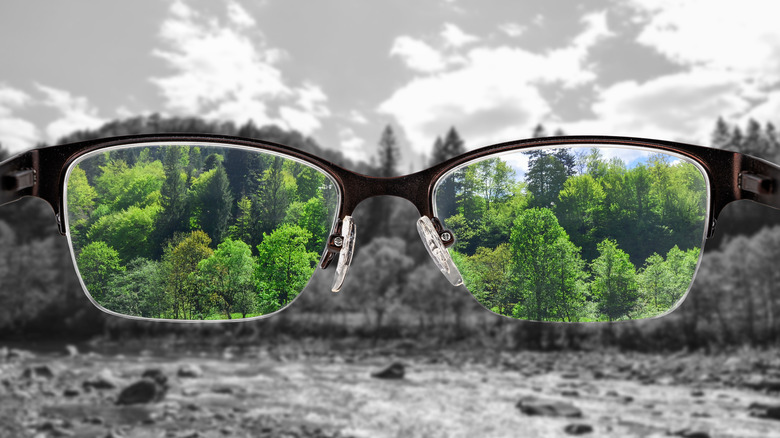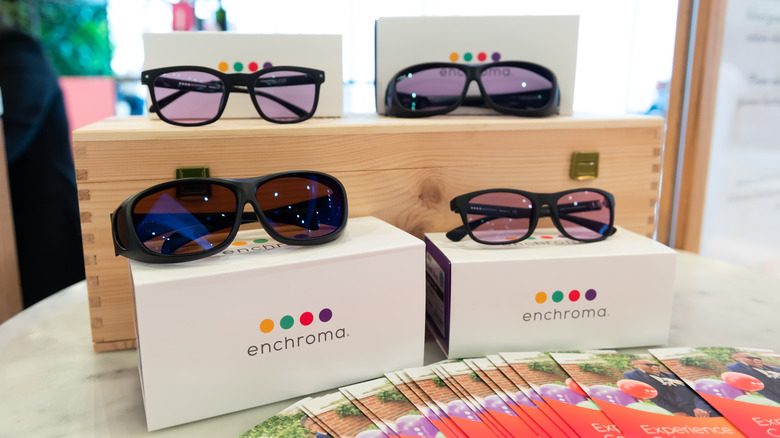Do Color Blind Glasses Actually Work? Here's What Users Say
Colorblind glasses aren't magic. They don't fix color blindness, and they don't give you "normal" color vision. What the glasses actually do is filter out specific wavelengths of light that normally confuse the brain. They reduce the overlap between red and green signals, helping users perceive more contrast between them.
But their effectiveness is a point of intense scrutiny. A 2018 study, carried out by the University of Granada Department of Optics, tested EnChroma glasses on 48 colorblind volunteers. Only one person reported a noticeable difference. They found that these glasses may make some colors more noticeable, but at the expense of others. And people online seem to agree with that sentiment, feeling like they got ripped off, calling these glasses a "scam," and advising not to invest in them.
Those reactions are not unfounded. These glasses won't change your perception if you're missing an entire type of cone cell. These cells are the ones responsible for the Purkinje Effect you see if you wear red and green clothes during a solar eclipse, and why school buses are painted yellow.
Luis Gómez Robledo, lead author of the 2018 study, writes, "The use of a colored filter may change the appearance of colors, but will never make color vision more similar to a normal observer's vision."
Reactions are real, but results are mixed
If you've seen those viral videos where someone puts on colorblind glasses and starts crying, you're probably wondering: Is that emotion legit or marketing hype? The answer is both. For people who've never clearly seen fall leaves, bright fruits, or color-coded schoolwork, the sudden difference can hit hard. But not everyone reacts that way.
Some people returned them after a brief use, like col_hap, who says, "Despite some skepticism, I got a pair of outdoor enchroma glasses last year but returned them after a brief trial run. While I did appreciate the enhanced separation of greens and browns, I certainly did not like the way the glasses affected the entire color gamut, effectively changing the way I perceived all other colors (e.g., blue objects appeared purple)."
Even those for whom these glasses do seem to work don't report an overwhelming reaction. What they notice instead is subtle, like DJ_Slomin puts it, "I have a pair myself and I enjoy them. I didn't have quite an emotional reaction, but I do notice many things that I didn't before, such as more color in the sky, flowers, someone's face, beautiful sunsets, and especially stoplights."
That said, placebo effects are real. It could just be that what these users are reporting is all in their heads, just like the effect of grounding sheets that were all the rage on TikTok a while back.
What buyers need to know before dropping $300
Colorblind glasses aren't cheap. EnChroma starts at $229. Pilestone is a bit cheaper at $109. Custom options like ColorCorrection System can hit $1,000 or more. Most brands aren't covered by insurance, though you might use HSA or FSA funds to help with the cost.
These glasses only work while you're wearing them, and they only help if your color blindness falls into a specific spectrum. If you're missing entire photoreceptors (like in protanopia or deuteranopia), the glasses won't do much. They're also not recommended for night driving, as the tinted lenses reduce light and can make things worse in low-visibility conditions.
Most brands offer indoor and outdoor models. Outdoor lenses in bright sunlight deliver the best results because higher light levels help the filters work more effectively. If you're just trying them out, look for brands with a return policy. You'll know within a few minutes if the glasses help or not.
Are they worth it? For many, yes, especially if you work with color, want to enjoy nature more fully, or just want to experience the world a bit differently. For others, the improvement is too minor to justify the price. Either way, talk to an eye doctor before buying, know your type, and try before you commit.


